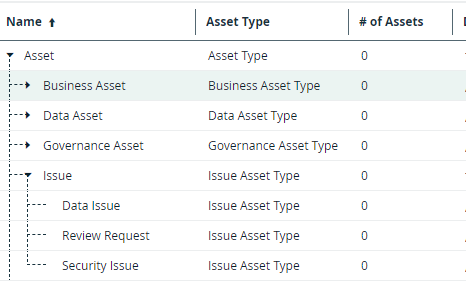43 Messages
OMRE (Operating Model Reverse Engineering)
This topic is created to discuss the current version of the OMRE (https://marketplace.collibra.com/listings/operating-model-reverse-engineering-omre/) as well as the possible improvements that could make this solution better.



Former User
1.2K Messages
3 years ago
The OMRE workflow shows the characteristics of an assignment as complex relation “Assignment Characteristics” which works fine and shows all the characteristics (attributes, relations) for a certain assignment of a specific asset type.
It would be good to add one more attribute to the complex relation type “Assignment Characteristics”, e.g. “Sequence Number” and populate this attribute with the actual sequence number of the characteristic in the assignment. The order of attributes and relations for a certain asset is quite important and it would be good if we reflect this also in the result of the OMRE workflow. Then a user could see the characteristics of a certain asset type assignment in the same order as an admin user sees them in the settings.
3
0
axelschots
16 Messages
3 years ago
In my opinion Collibra should make this functionality as core of their product and not just offer it towards Collibra Lab.
I appreciate this integration as it delivers valuable information (lacking from the core product) ,
but since R2021.01 release it broke multiple times.
At the time of writing I face the following error:
Caused by: com.collibra.dgc.core.exceptions.DGCException: Attribute Type has not been found
at sun.reflect.NativeConstructorAccessorImpl.newInstance0(Native Method)
at sun.reflect.NativeConstructorAccessorImpl.newInstance(NativeConstructorAccessorImpl.java:62)
at sun.reflect.DelegatingConstructorAccessorImpl.newInstance(DelegatingConstructorAccessorImpl.java:45)
at java.lang.reflect.Constructor.newInstance(Constructor.java:423)
Can someone of Collibra Lab contact me in debugging this please?
We currently are on the latest version 1.1.2
Kind regards
Axel
2
0
pranaymahendra
70 Messages
3 years ago
@tracy.williams - You may want to follow this thread and post your questions here about the OMRE workflow.
Thanks!
0
0
spencerrockman
5 Messages
3 years ago
I also think the OMRE is terrifically useful. If it could be integrated into the base product it would be extremely beneficial for a lot of organisations.
0
0
vladimirschwarz
2 Messages
3 years ago
Dear @lugovyi.dmytro ,
Thanks for opening this topic. We use OMRE in our company heavily. We have also expanded by adding several new columns. In the area of user management for example we use it to track inactive users (who left the company for example) so that we relocate assets they owner to a new owner. Our data governance council counts on it.
We noticed that OMRE is getting slower with each additional feature added. I agree with previous ideas to make it a core functionality of Collibra, have it fully supported and be able to run it faster than now.
Unfortunately it also has some known bugs like the maximum of 100.000 counted assets per type which would be hopefully fixed by integrating it into the product.
Thanks for taking this into considerations for the OMRE roadmap
Regs,
Vlado
1
0
michaelmoulin
2 Messages
3 years ago
We are considering within our team to use the OMRE asset model and a dedicated community to document the view of the OM that apply to our company specifically. We would use it to do meta-govern as well as to do some form of change control. E.g. changes to the OM are drafted in our community, approved and applied to the actual platform settings via Workflow+API. By comparing the OMRE output with our community, we could confirm successful deployment/implementation of the change. Maybe this is too far fetch for the original intent of OMRE.
2
0
ingriddapper
7 Messages
3 years ago
We also think OMRE is very useful for us. This week we find the following error:
WARN o.f.e.i.b.b.ScriptTaskActivityBehavior - Exception while executing scripttask_omre : problem evaluating script: javax.script.ScriptException: java.util.NoSuchElementException: Cannot access first() element from an empty List
[jobExecutor-2] ERROR c.c.d.c.w.a.WorkflowExceptionHandler - Error starting workflow with id: scriptOperatingModelReverseEngineering
It took some time to find out which list was empty.
Cause was renaming a domain and creating a new domain with the old name.
Are these situations fixed in the new version?
Kind regards, Ingrid
2
0
marieaudemagarshack
32 Messages
3 years ago
Hello, Collibra Support’s reply is that this normal, because “Issues” is a system domain. I have contacted the publisher to know if it can be avoided.
1
0
marieaudemagarshack
32 Messages
3 years ago
Hello @dmytro.lugovyi@collibra.com, thank you for replying. No data issues have been recorded in any community, we are not using this feature yet. . It cannot be the right explanation.
. It cannot be the right explanation.
It is not critical, but it is disturbing for our Collibra users. They are mostly unhappy with their initial user experience and adoption is still low. I hoped to have good news to share with them with the OMRE information. But this system domain is going to raise a lot of unnecessary questions.
0
0
dmytrolugovyi
43 Messages
3 years ago
Hi @marie-aude.magarshack, the screenshot you shared shows the out-of-the-box asset types. They can’t be removed. I was referencing Issue Domains which will be created automatically if you create a new data issue and assign it to one of the communities.
There are a lot of benefits from using OMRE, such as - it should help advanced users understand the Collibra Operating Model better or it will help you to control changes in the Operating Model and build governance processes on top. But for users who just started to use Collibra, I would recommend using another approach.
There is a quite new course at the Collibra University that may help you with some ideas on how to increase the adoption of the platform. How to find it - go to the Collibra University and search for the course "Supporting User Adoption of the Collibra Platform”. There are a few sections in this course and at the end of each session, you will find the links to the documents and templates you can download.
0
0
marieaudemagarshack
32 Messages
3 years ago
Hello Dmytro, I still do not understand your reply “Issue Domains which will be created automatically if you create a new data issue and assign it to one of the communities”. We have not created any data issue. Never mind.
Thank you for the heads-up about this new course, I will listen to it.
Best regards
3
0
marieaudemagarshack
32 Messages
3 years ago
Hello Alvin, got your point, thank your for the guidelines! I am going to follow your tip and run the workflow again.
0
0
marieaudemagarshack
32 Messages
3 years ago
@lugovyi.dmytro, Hello Dmytro, I have another question regarding the OMRE workflow. I have executed it 2ce already, 2nd time with all the options that take more time: users, user groups, count of assets. I did not notice any degradation in the application performance and response time. Still, should we be careful here? Do you recommend to run the workflow out of usual business hours, in order not to impact the users?
Best regards
1
0
marieaudemagarshack
32 Messages
3 years ago
Hello @lugovyi.dmytro, thank you for the recommendation. Well noted.
0
0
gingermillheim
1 Message
3 years ago
Hi Dmytro,
I worked with Chris Brewer on the WF and he recommended you for the further questions. My WF is up and running but wanted to explore 2 things.
Thank you,
Ginger
1
0